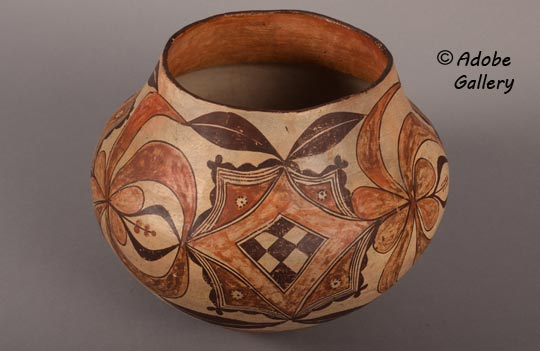Laguna Pueblo Elaborate Historic Polychrome Jar [SOLD]
+ Add to my watchlist Forward to Friend
- Category: Historic
- Origin: Laguna Pueblo, Ka'waika
- Medium: clay, pigment
- Size: 9-½” height x 11-¾” diameter
- Item # C4852F SOLD
This elaborately painted circa 1890s polychrome jar was meant to attract the attention of a buyer visiting the Southwest, probably arriving on the *AT&SF train that made a daily stop at Laguna Pueblo as early as the 1880s.
Acoma and Laguna Pueblo pottery are often indistinguishable, which is logical, because in 1699 a portion of Acoma's population left the community in fear of military reprisals from the Spanish in revenge for the Pueblo revolt of 1680. This group started a new Pueblo, referred to as Laguna, and certain historic Laguna potters evolved their own style unique to this Pueblo. Of course, there are influences from their previous home pueblo.
This jar has a beautiful round shape with a mid-body expansion. The design chosen was meant to be bold and was extended to the neck section for a larger canvas on which to paint. A strong design is the diamond within a diamond of orange color surrounding a checkerboard field. This strong design is superimposed over an elaborate lighter element of orange triangles outlined by fine black lines and framed with solid black half ovals.
Separating these bold designs are softer ribbon-like elements growing out from a four-petal flower with a seed pod. At the upper and lower parts of the overall design are split-leaf elements. This extraordinary design concept was the creation of a very talented potter and painter. The artist of this historic Laguna Pueblo water jar took wonderful liberties elaborating on many traditional decorative elements.
Each of these designs was repeated three times surrounding the jar. Laguna Pueblo potter Gladys Paquin commented to Rick Dillingham that she studied Acoma and Laguna pottery designs and realized that Laguna potters repeated designs in threes rather than fours. [Dillingham 1992:88]
Another quote from Dillingham is "Certain minor variations at each pueblo can be noted, though there are always exceptions to these generalizations. An open ‘chain-link' patterning, sometimes with a heart-shaped motif or other central element, is characteristic of Laguna and creates a sense of movement or flow around the central portion of the jar. From the mid-1800s to around 1930 a more spacious quality of design is typical of Laguna pots, as are bolder elements connected with split-leaf (arc) patterns. . . [ibid 112]
It is my opinion that this jar was made by a potter of Laguna Pueblo, not a potter of Acoma Pueblo. Others may disagree, but that has been the situation for several decades, and each of us makes the decision for ourselves.
*AT&SF: The Atchison, Topeka and Santa Fe Railway (reporting mark ATSF), often abbreviated as Santa Fe or AT&SF, was one of the larger railroads in the United States. Chartered in February 1859, the railroad reached the Kansas-Colorado border in 1873 and Pueblo, Colorado, in 1876. To create a demand for its services, the railroad set up real estate offices and sold farm land from the land grants that it was awarded by Congress. Despite the name, its main line never served Santa Fe, New Mexico, as the terrain was too difficult; the town ultimately was reached by a branch line from Lamy.
Condition: very good condition
Provenance: this Laguna Pueblo Elaborate Historic Polychrome Jar is from the estate of a Santa Fe resident
Reference and Recommended Reading: Acoma & Laguna Pottery by Rick Dillingham
TAGS: Southwest Indian Pottery, Acoma Pueblo, Historic Pottery, Laguna Pueblo, Ka'waika

- Category: Historic
- Origin: Laguna Pueblo, Ka'waika
- Medium: clay, pigment
- Size: 9-½” height x 11-¾” diameter
- Item # C4852F SOLD
Adobe Gallery Recommended Reading
Adobe Gallery Recommended Items
If you are interested in this item, we would also like to recommend these other related items:



